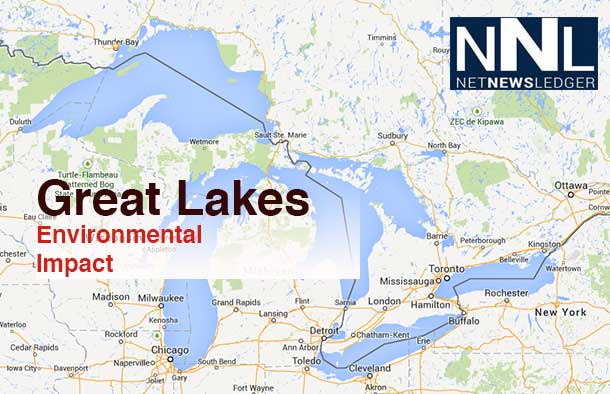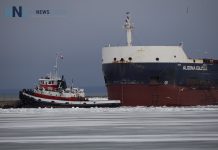
Lake Superior and Great Lakes Impact
THUNDER BAY – News – Lake Superior has an enormous impact on Thunder Bay and communities all around the greatest of the Great Lakes,
Cold weather in the winter offers greater ice coverage of the lake, and prevents evaporation. That helps the water level stay higher and that helps shipping on the lakes.
Great Lakes Integrated Sciences and Assessments Center (GLISA) reports, “The recent Arctic blast that gripped much of the nation will likely contribute to a healthy rise in Great Lakes water levels in 2014, new research shows. But the processes responsible for that welcome outcome are not as simple and straightforward as you might think.
“Yes, extreme winter cold increases ice cover on the Great Lakes, which in turn reduces evaporation by preventing water vapor from escaping into the air. But this simplistic view of winter ice as a mere “cap” on Great Lakes evaporation is giving way to a more nuanced conception, one that considers the complex interplay among evaporation, ice cover and water temperature at different times of year”.
Thunder Bay Mayor Hobbs states, “The level of Lake Superior last year was drastically improved over the last several years. Climate change and evaporation are complex issues that are going to require years of research to fully understand trends. The GLSLCI, IJC and other environmental groups and all levels of government have to work together to work on Climate Change initiatives. The recent unveiling of the MARS project is one example”.
High evaporation rates in the fall can nearly offset water-level gains that result from extensive winter ice cover, complicating efforts to forecast Great Lakes water levels, which have declined in most of the lakes since the late 1990s, rebounding somewhat during a wet 2013.
Municipal Adaptation and Resiliency Service (MARS)
At its mid-year meeting hosted by Windsor Mayor Eddie Francis, Mayor Hobbs joined other mayors of the Great Lakes and St. Lawrence Cities Initiative to launch the Municipal Adaptation and Resiliency Service (MARS). The Honourable Teresa Piruzza, MPP for Windsor West, announced $145,000 in funding from the Government of Ontario to support the program. MARS will help municipalities accelerate local adaptation to climate change in the Great Lakes region.
Municipalities of the Great Lakes and St. Lawrence region are feeling the effects of climate change already, from flooding in Thunder Bay and Duluth and the prolonged drought in the American Midwest in 2012, to historically low water levels in the Great Lakes and rapid erosion of the St. Lawrence. Most recently, an extreme storm hit the Greater Toronto area this summer and caused widespread flooding and damage.
“The City of Thunder Bay experienced extreme rainfall and flooding in 2012, and we learned from the experience. MARS will help all of us be more aware of what to expect from our changing climate, and be better prepared,” said Mayor Hobbs, chair of the Great Lakes and St. Lawrence Cities Initiative.
MARS is made possible through the support of the Ontario Government. The Ontario Ministry of the Environment’s Great Lakes Strategy includes support for local adaptation in the Great Lakes region.
“Climate change is real, it’s here, and its impacts are being felt in the Great Lakes region, its tributaries and its shoreline. By teaming up with the Great Lakes and St. Lawrence Cities Initiative, the Ontario Government is pleased to support adaptation in the Great Lakes region,” said the Honourable Teresa Piruzza, member of provincial parliament for Windsor West.
As a starting point, members of the Cities Initiative will issue a Call to Action, documenting each municipality’s adaptation measures to be implemented over the next two years.
MARS will then provide support for these activities through a Community of Practice portal hosted by the Ontario Centre for Climate Impacts and Adaptation Resources (OCCIAR). The portal is a one-stop shop for adaptation resources, and also serves as an interactive forum for municipal mayors and staff to share information and ideas on adaptation. A series of training webinars hosted by the Clean Air Partnership (CAP) will focus on measures to start and expand adaptation locally. MARS will also put practical tools in the hands of municipalities to assess their vulnerability to climate change.
“The Call to Action demonstrates local governments’ commitment to adaptation right across the Great Lakes basin,” said Racine Mayor John Dickert, Cities Initiative Secretary-Treasurer, “and the MARS program provides us with the building blocks to get us there.”
For more information on MARS and the Call to Action, please visit www.glslcities.org/MARS.cfm.
The Great Lakes and St. Lawrence Cities Initiative (www.glslcities.org) is a binational coalition of 111 mayors and other local officials, representing over 17 million citizens, that works actively with federal, state, tribal, first nation and provincial governments and other stakeholders to advance the protection, restoration and promotion of the Great Lakes and St. Lawrence River basin.











